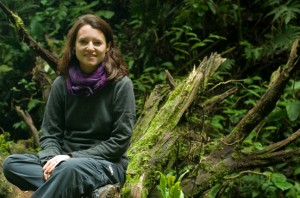
Sabrina Setaro, PhD. is the Program Coordinator for BioBook
Adjunct Assistant Professor
and Program Coordinator for BioBook
M.S. Biology, University of Tübingen, Germany (2004)
Ph.D. Mycology and Botany, University of Tübingen, Germany (2007)
205 Winston Hall
(336) 758-3810
setarosd@wfu.edu
Areas of Interest
Evolution and ecology of mycorrhizal fungi, plant-fungi symbioses, diversity of root fungi, using electronic media to promote education and citizen science.
Research
The evolutionary history of mycorrhizal fungi and their plant partners goes as far back as the origin of land plants. I am interested in how this association influences diversification and specialization of mycorrhizal fungi and their hosts. I use phylogenetic and network analyses to detangle the complexity of mycorrhizal networks and want to understand how these contribute to ecosystem functioning and maintenance of species diversity.
I advocate for citizen science and open access to scientific data. Currently, collaborators and I are developing a citizen science project that focuses on mycorrhizal fungi from tropical rain forests. The aim is to engage the public in research and provide information about root fungi and mycorrhizae. This project will be integrated into BioBook, a multimedia teaching and learning tool which we are developing at WFU.
Selected Publications
Garnica S, Riess K, Schön ME, Oberwinkler F, Setaro SD. 2016. Divergence Times and Phylogenetic Patterns of Sebacinales, a Highly Diverse and Widespread Fungal Lineage. PLoS One. DOI: 10.1371/journal.pone.0149531
Setaro S, Suárez JP, Herrera P, Cruz D, Kottke I. 2013. Distinct but closely related Sebacinales form mycorrhizae with coexisting Ericaceae and Orchidaceae in a Neotropical mountain area. In: Oelmueller R, Kost G, Tripathi S, Varma A, editors. Piriformospora indica – Sebacinales and their biotechnological applications. (pp. 81-106). Heidelberg, New York, Dordrecht, London: Springer Verlag.
Haug I, Setaro S, Suarez JP. 2013. Reforestation sites show similar and nested AMF communities to an adjacent pristine forest in a tropical mountain area of South Ecuador. PLoS One. DOI: 10.1371/journal.pone.0063524.
Schuster T, Setaro S, Kron K. 2013. Age estimates for the buckwheat family Polygonaceae based on sequence data calibrated by fossils and with a focus on the amphi-Pacific Muehlenbeckia. PLoS One. DOI: 10.1371/journal.pone.0061261.
Kottke I, Setaro S, Haug I, Herrera P, Cruz D, Fries A, Gawlik J, Homeier J, Werner F, Gerique A, Suárez JP. 2013. Chapter 14 Provisioning services of non-timber products in the Reserva Biológica San Francisco: Mycorrhiza networks promote biodiversity and stabilize the tropical mountain rain forest ecosystem – perspectives for understanding complex communities. In: Ecosystem services, biodiversity and environmental change in a tropical mountain ecosystem of South Ecuador. Bendix J, Beck E, Braeuning A, Makeschin F, Mosandl R, Scheu S, Wilcke W (eds.) Ecological Studies, Vol. 221. (pp. 187-203). Heidelberg, New York, Dordrecht, London: Springer Verlag.
Setaro S, Garnica S, Herrera, PI, Suárez JP, Göker M. 2012. A clustering optimization strategy to estimate species richness of Sebacinales in the tropical Andes based on molecular sequences from distinct DNA regions. Biodiversity and Conservation. DOI: 10.1007/s10531-011-0205-y.
Setaro S, Kathleen A Kron. 2011. Neotropical and North American Vaccinioideae (Ericaceae) share their mycorrhizal Sebacinales – an indication for concerted migration? PLoS currents Tree of Life. PLoS Curr. 3: RRN1227. Doi: 10.1371/currents.RRN1227.
Lehnert M, Kottke I, Setaro S, Pazmiño LF, Suárez JP, Kessler M. 2009. Mycorrhizal Associations in Ferns from Southern Ecuador. American Fern Journal. 99: 292-306.
Kottke I, Haug I, Setaro S, Suárez JP, Weiss M, Preußing M, Nebel M, Oberwinkler F. 2008. Guilds of mycorrhizal fungi and their relation to trees, ericads, orchids and liverworts in a Neotropical mountain rain forest. Basic and Applied Ecology 9: 13-23.
Selosse MA, Setaro S, Glatard F, Richard F, Urcelay C, Weiss M. 2007. Sebacinales are common mycorrhizal associates of Ericaceae. New Phytologist. 174: 864-878.
Setaro S, Kottke I, Oberwinkler F. 2006. Anatomy and ultrastructure of mycorrhizal associations of Neotropical Ericaceae. Mycological Progress 5: 243-254.
Setaro S, Weiss M, Oberwinkler F, Kottke I. 2006. Sebacinales form ectendomycorrhizas with Cavendishia nobilis, a member of the Andean clade of Ericaceae, in the mountain rain forest of southern Ecuador. New Phytologist. 169: 355-365.